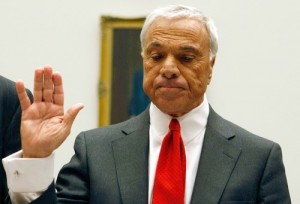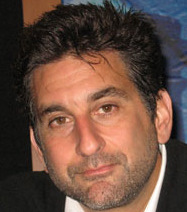The business media is in self-flagellation mode and with good reason. Editors are beginning to pick up the pieces and wonder how they managed to miss the biggest economic story of the last 50 years. Liberal commentators are having a field day.
Did the media blow it in failing to predict the financial crisis? Eric Alterman sums up a variety of perspectives and suggests that the real problem with US financial journalism is that at some point journalists stopped treating their audience as consumers and started treating them as investors.
Insiderism, the cult of personality and a lopsided emphasis on stock market performance created an oversimplified view of the financial world that led readers to believe that that super executiv es could defy gravity. The result was business sections running flattering profiles of people like Countrywide Financial’s Angelo Mozilo (right) even as those executives were driving their companies into the ground.
es could defy gravity. The result was business sections running flattering profiles of people like Countrywide Financial’s Angelo Mozilo (right) even as those executives were driving their companies into the ground.
Alterman quotes a report from the UK’s POLISMedia: “If journalists see themselves mainly or merely as serving the market or investors, they may be less effective in their watchdog role…. Ultimately, do journalists have a broader professional duty to ensure that corporate malpractice comes to light, or is their role merely to provide whatever their readers want?”
He also points to an even more damning account in Mother Jones by former Wall Street Journal reporter Dean Starkman and bluntly titled “How Could 9,000 Business Reporters Blow It?” Starkman was a member of the financial press corps that transformed itself from loyal opposition to chummy insider as the bubble grew. “I rode in black cars, lunched at all the places you read about, and more than once flew across the country to report a 1,200-word story,” he writes.
 Reporters and the subjects of their reports both benefited from the Wall Street boom, creating little incentive for either side to end the party. The result was a rash of glowing coverage of larger-than-life executives and very little investigation into what they were executing. Starkman (left) pays homage to “The Reckoning,” a 1990 Wall Street Journal account of the devastating human toll of a corporate leveraged buyout. “It is safe to say that that piece, which tied the Safeway LBO to workers’ suicides, heart attacks, and more, would never be proposed, let alone published, today,” he writes.
Reporters and the subjects of their reports both benefited from the Wall Street boom, creating little incentive for either side to end the party. The result was a rash of glowing coverage of larger-than-life executives and very little investigation into what they were executing. Starkman (left) pays homage to “The Reckoning,” a 1990 Wall Street Journal account of the devastating human toll of a corporate leveraged buyout. “It is safe to say that that piece, which tied the Safeway LBO to workers’ suicides, heart attacks, and more, would never be proposed, let alone published, today,” he writes.
He’s also blunt in attacking the formulaic executive profiles that conferred a god-like aura on corporate executives while paying scant attention to the underlying rot in their businesses. “Personality profiles, critical as they may be, are comfortably within the narrowing business-press discourse. Plus they’re a lot easier, and less risky, than investigations-and it’s that part of business journalism that has been allowed to wither,” Starkman writes, quoting Fortune‘s Katie Brenner.
Ultimately, insiderism ruins objectivity. “Increasingly, business coverage has addressed its audience as investors rather than citizens, a subtle but powerful shift in perspective that has led to some curious choices,” Starkman writes, citing as an example the Journal‘s claim that borrower fraud was a big part of the subprime financial mess when no such evidence existed.
Much attention is being focused on the damaging impact of layoffs on newspapers’ watchdog role. Reading these two pieces, one gets the sense that in the case of the financial press at least, the watchdogs were inside snuggled comfortably at the feet of their masters.
Layoff Log
Three dozen employees of the Buffalo News have accepted a generous buyout offer of a minimum $60,000 cash payment, but that’s still not enough. The Berkshire Hathaway-owned newspaper may need to cut another 21 jobs. That would be about 6.5% of the company’s 900-person workforce.
The Wichita Eagle is one of McClatchy’s top-performing newspapers, so it only has to lay off 5% of its workforce.
The Fargo-Morehead (N.D.) Forum is eliminating 25 more full-time jobs on top of the 21 it cut last month. Altogether, that amounts to 19% of its 240-person workforce. The neighboring Grand Forks Herald is cutting eight jobs and will end publication of an advertorial supplement.
The Toledo Newspaper Guild is pleading with management of the Toledo Blade not to lay off as many as 60 more people. The newspaper laid off 23 people in December, mostly in the newsroom. The new cuts could amount to as much as 14% of its remaining 425-person workforce.
Comments
This entry was posted on Friday, March 13th, 2009 at 7:39 am and is filed under Facebook. You can follow any responses to this entry through the RSS 2.0 feed. Both comments and pings are currently closed.



There were ZERO sleeping watchdogs.
The watchdogs were on the take, and that is not the same thing.
The point made is correct, but misses the broader perspective: this is hardly a problem limited to the business media. The ENTIRE media is in bed with their subjects by this stage, be it business, political, sports (especially sports), entertainment, you name it. Among the political media, it’s the catch-22 of access vs. real vigilance: you can’t get the real news without access to the newsmakers, but if you print the real news, you’ll be denied that access. This is why earmarking has run so rampant, among other things. In sports, the sports reporters are a bunch of inveterate jock-sniffers, and the entertainment reporters are essentially the same with actors, singers, and so forth.
And then, of course, there’s that line from the movie “The Paper”, that goes something like, We move in their world, but it’s THEIR world. Newspapermen (back when they were newspapermen, and not “journalists”) used to understand this, and it helped maintain a wall of objectivity between them and their subjects. But that wall has largely dissolved, and the more that journalists seek to become part of that world, and succeed in doing so, the more that such objectivity vanishes, and journalists become mouthpieces for those on whom they are supposed to be watching. They simply become yet another part of the problem.
If you leave out the national papers in New York and Washington, you could generally say that the chains neutered their business reporters 20 years ago or more. The last thing the publishers wanted was some investigative reporter who understood how to follow the money. That always ends up embarrassing big advertisers.
That message was communicated effectively to editors, who eventually weeded out the investigative trouble-makers and left the softball feature writers in place.
I would lay the blame at the feet of the newspaper chain owners. Now they are reaping the fruits of their purposeful dumbing-down.
Will someone please explain to me what is “critical” about personality profiles, except in that they are necessary in order for reporters (and their editors) to ingratiate themselves with the article’s wealthy, well-connected subjects?